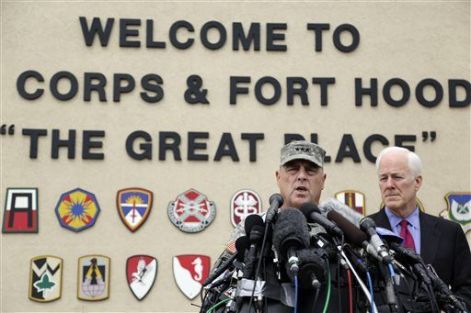Last week, four people, including the gunman, were killed and 16 others wounded at the Fort Hood army post in Texas. This is the same Army base where U.S. Army Major Nidal Malik Hassan killed 13 people and wounded 30 others less than three years ago.
Last week’s shooting brought back painful reminders of that November day, and raised fears that terrorism was, once again, behind the attack.
This was not the case, however.
Army Specialist and Iraqi War veteran Ivan Lopez was identified as the shooter. Before the shooting, Lopez was diagnosed with depression and anxiety and had trouble sleeping. He was also being evaluated for post-traumatic stress disorder.
It is unclear if PTSD played any role in Lopez’s rampage last week, but the shooting brings attention back to veterans and returning soldiers who are coping with PTSD and the question of if enough is being done to properly diagnose and treat them.
All soldiers undergo a debriefing process when they return from active duty, which involves a series of interviews and other evaluations. If this process indicates the soldier may have PTSD, full medical evaluations follow. A diagnosis of PTSD in the military is largely based on self-reporting, but many service members downplay symptoms for a number of reasons.
One reason is the stigma associated with PTSD. Other reasons are because soldiers see a PTSD diagnosis as a sign of weakness, or because it may harm their military careers. Fifty percent of those with PTSD do not seek treatment.
According to Michael Telch, psychology professor at the University of Texas-Austin, it can take months before a diagnosis is officially recognized by the military. In addition, Dr. Elspeth Ritchie, former chief Army psychiatrist, said that just over half of those diagnosed with PTSD receive timely or “minimally adequate” treatment. Why is this the case? First, a study found the Pentagon’s efforts to cope with behavioral health, among other things, were inadequate. Second, it could cost $1.5 million to treat one soldier with PTSD over the course of a lifetime. As a result, military and Veterans Health Administration personnel try to minimize or even deny PTSD diagnoses. Or, if possible, they try to re-diagnose soldiers with other, less severe, conditions.
This is reason enough to make one question how it is possible that the military’s budget is hindering soldiers’ receiving the proper diagnoses and treatments that they need. In the same light, one must question why the military is allowing these soldiers to continuously fall through the cracks, increasing the possibility that they become violent or commit suicide.
The military is doing these service men and women a disservice.
Studies have found that combat veterans with PTSD are two-to-three times more likely than other combat veterans to commit domestic violence or other violent acts. Mass shooting and mental illness experts say that only a small member of them commit violent acts, but it is very difficult to predict who will react that way.
A powerful “60 Minutes” segment that aired last December featured soldiers undergoing the newest therapy treatments at an eight-week program in Little Rock, Ark.
One of the treatments is called prolonged exposure, which requires soldiers to remember and relive every haunting detail of their experiences on the battlefield five times a session. Seventy-seven percent of those who made it through the program saw a drop in PTSD symptoms. This is a promising treatment option for soldiers who need the help, but convincing them to look for help is the real challenge.
The segment also allowed viewers to see how these soldiers really felt, and what they dealt with every day of their lives. Some talked about their marital and family problems, feelings of isolation and misunderstanding, suicidal thoughts and attempts and “survivor’s guilt” [the notion of “Why did I survive over all the men that died?”]. This combination of internal conflicts led to substance abuse and severe depression.
We add to their pain by labeling them as dangerous, psychotic, “ticking time bombs” and unstable just because they are diagnosed with PTSD. This discourages soldiers from seeking help and increases the risk of violence to themselves and others.
Data from the Department of Veterans Affairs shows that PTSD affects up to 20 percent of the 2.8 million soldiers who served in Afghanistan and Iraq, as many as 10 percent of Gulf War veterans, and about 30 percent of Vietnam veterans. 1000 veterans of the Iraq and Afghanistan war era are diagnosed with PTSD each week according to a Veterans Affairs statistic.
What happened at Fort Hood is tragic. It is a reminder that there are soldiers who return distraught from war, and who are being forgotten.
The U.S. government and military need to act now.
Returning soldiers are going undiagnosed, refusing to seek treatment and making the wrong decisions. PTSD screenings must become stricter.
Treatments and therapies need reform. Programs that assure soldiers there is no shame in looking for help in order to help them self-report their PTSD have to continue.
The soldiers who fight for our country and our freedom deserve better care for making this tremendous sacrifice.
Let us stop ignoring them, and help them rebuild their lives.
Andrew Santis, GSB ’16, is a business administration major from Flushing, N.Y.





